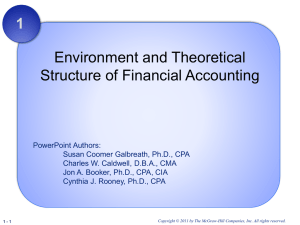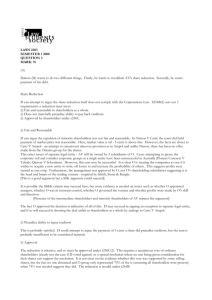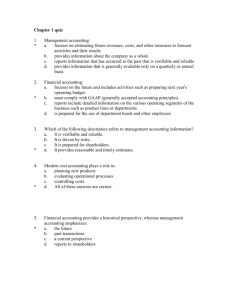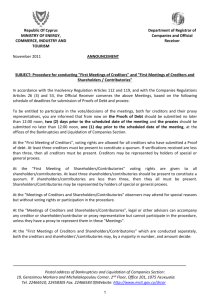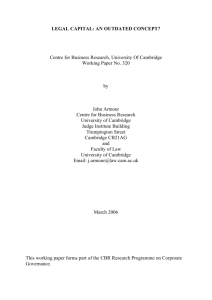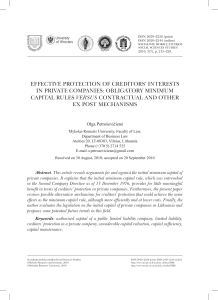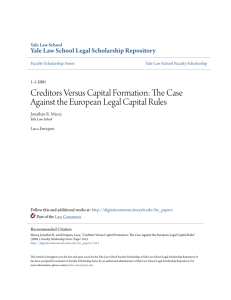Md. Ataur Rahman, Management Accounting, Financial Accounting
advertisement
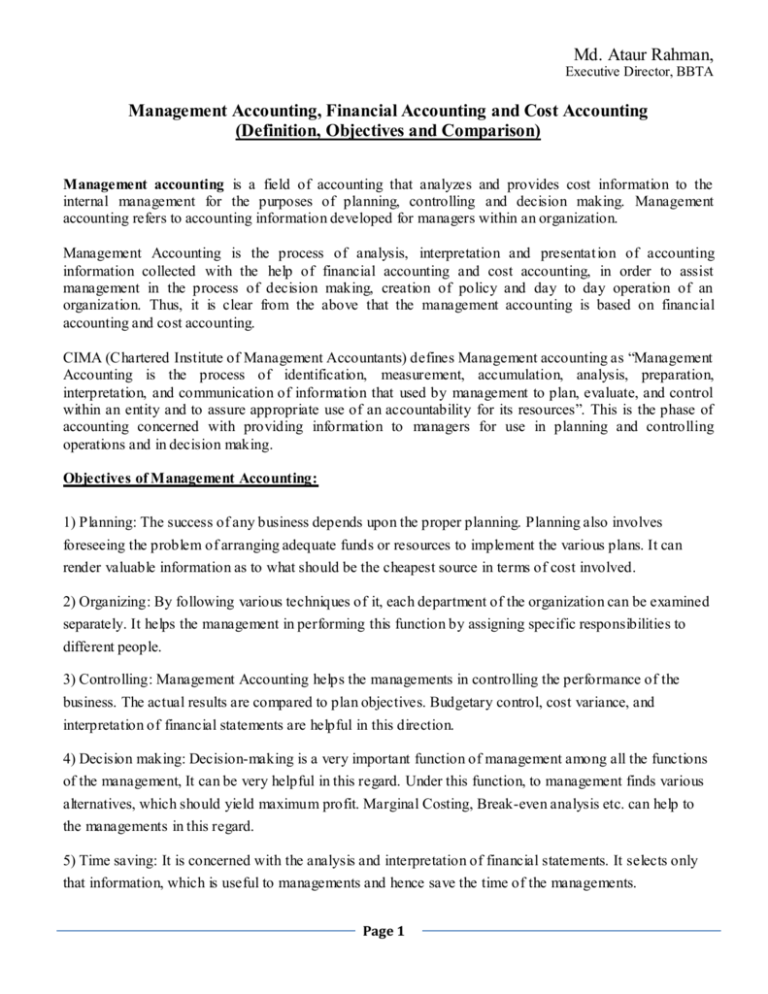
Md. Ataur Rahman, Executive Director, BBTA Management Accounting, Financial Accounting and Cost Accounting (Definition, Objectives and Comparison) Management accounting is a field of accounting that analyzes and provides cost information to the internal management for the purposes of planning, controlling and decision making. Management accounting refers to accounting information developed for managers within an organization. Management Accounting is the process of analysis, interpretation and presentat ion of accounting information collected with the help of financial accounting and cost accounting, in order to assist management in the process of decision making, creation of policy and day to day operation of an organization. Thus, it is clear from the above that the management accounting is based on financial accounting and cost accounting. CIMA (Chartered Institute of Management Accountants) defines Management accounting as “Management Accounting is the process of identification, measurement, accumulation, analysis, preparation, interpretation, and communication of information that used by management to plan, evaluate, and control within an entity and to assure appropriate use of an accountability for its resources”. This is the phase of accounting concerned with providing information to managers for use in planning and controlling operations and in decision making. Objectives of Management Accounting: 1) Planning: The success of any business depends upon the proper planning. Planning also involves foreseeing the problem of arranging adequate funds or resources to implement the various plans. It can render valuable information as to what should be the cheapest source in terms of cost involved. 2) Organizing: By following various techniques of it, each department of the organization can be examined separately. It helps the management in performing this function by assigning specific responsibilities to different people. 3) Controlling: Management Accounting helps the managements in controlling the performance of the business. The actual results are compared to plan objectives. Budgetary control, cost variance, and interpretation of financial statements are helpful in this direction. 4) Decision making: Decision-making is a very important function of management among all the functions of the management, It can be very helpful in this regard. Under this function, to management finds various alternatives, which should yield maximum profit. Marginal Costing, Break-even analysis etc. can help to the managements in this regard. 5) Time saving: It is concerned with the analysis and interpretation of financial statements. It selects only that information, which is useful to managements and hence save the time of the managements. Page 1 6) Measuring performance: Management accounting measures two types of performance. First is employee performance and the second is efficiency measurement. The actual performance is measured with the standardized performance and a report of deviation from the standard performance is reported to the management for the effective decision making and also to indicate the effectiveness of the methods in use. Both types of performance management are used to make corrective actions in order to improve performance. 7) Assess Risk: The aim of management accounting is to assess risk in order to minimize risk. 8) Allocation of Resources: is an important objective of Management Accounting. 9) Presentation of various financial statements to the Management. Financial Accounting is the process of recording, summarizing and reporting the myriad (a countless or extremely great number of people or things) of transactions from a business, so as to provide an accurate picture of its financial position and performance. The primary objective of financial accounting is the preparation of financial statements - including the balance sheet, income statement and cash flow statement - that encapsulates the company's operating performance over a particular period, and financial position at a specific point in time. These statements - which are generally prepared quarterly and annually, and in accordance with Generally Accepted Accounting Principles (GAAP) or International Financial Reporting Standards (IFRS) - are aimed at external parties including investors, creditors, regulators and tax authorities. Objectives of Financial Accounting: The purpose of accounting can be summarized in the following manner: 1. Ascertain the results of operations during a period 2. Ascertain the financial position. 3. Maintaining a control over assets 4. Planning in respect of cash 5. Providing information to tax authorities and other government agencies. 6. To properly match income with expenses. 7. To provide a reliable set of data with which to prepare financial reports for analysis p urposes (for owners, lenders, investors, etc). 8. To provide a reliable set of data with which to report income for tax purposes. Page 2 Difference Between Financial Accounting and Management Accounting Financial accounting is concerned with providing information to stockholders, creditors, and others who are outside an organization. Managerial accounting provides the essential data with which organizations are actually run. Financial accounting provides the scorecard by which a company’s past performance is judged. In contrast, management accounting is concerned with providing information to managers i.e. people inside an organization who direct and control its operations. The differences between Financial Accounting and Management Accounting are given below: Financial Accounting Management Accounting External vs. Internal A financial accounting system produces information that is used by parties external to the organization, such as shareholders, bank and creditors. Segment reporting Pertains to the entire organization or materially significant business units. Focus Financial accounting focuses on history. Format Financial accounts are supposed to be in accordance with a specific format, so that financial accounts of different organizations can be easily compared. (Formal recordkeeping) Planning and control Financial accounting helps in making investment decisions, and in credit rating. Information Quantitative and monetary Users Financial accounting reports are primarily used by external users, such as shareholders, bank and creditors. Reporting frequency and duration Well-defined - annually, semi- annually, quarterly. (Verifiable) As needed - daily, weekly, monthly. Optional? Preparing financial accounting reports are mandatory especially for limited companies. There are no legal requirements to prepare reports on management accounting. Page 3 A management accounting system produces information that is used within an organization, by managers and employees. May pertain to smaller business units or individual departments, in addition to the entire organization. Management accounting focuses on future & present. No specific format is designed for management accounting systems. (Formal and informal recordkeeping) Management accounting helps management to record, plan and control activities to aid decision- making process. Quantitative and qualitative; Monetary and non- monetary Management accounting reports are exclusively used by internal users viz. managers and employees. Financial Accounting Objectives Legal/rules Accounting process The main objectives of financial accounting are :i) to disclose the end results of the business, and ii) to depict the financial condition of the business on a particular date. Drafted according to GAAP - General Accepted Accounting Procedure or International Financial Reporting Standards. Follows a full process of recording, classifying, and summarizing for the purpose of analysis and interpretation of the financial information. Management Accounting The main objectives of Management Accounting are to help management by providing information that used by management to plan, evaluate, and control. Drafted according to management suitability. Cost accounts are not preserved under Management Accounting. The necessary data from financial statements and cost ledgers are analyzed. Cost Accounting is a type of accounting process that aims to capture a company's costs of production by assessing the input costs of each step of production as well as fixed costs such as depreciation of capital equipment. Cost accounting will first measure and record these costs individually, then compare input results to output or actual results to aid company management in measuring financial performance. While cost accounting is often used within a company to aid in decision making, financial accounting is what the outside investor community typically sees. Financial accounting is a different representation of costs and financial performance that includes a company's assets and liabilities. Cost accounting can be most beneficial as a tool for management in budgeting and in setting up cost control programs, which can improve net margins for the company in the future. Is Financial accounting cost accounting? Cost accounting is usually involved with management accounting. Financial accounting tends to deal with the past and presents information like statements for public and private use. Management accountants are involved with the budgeting and costing sides of things and present information only for the sole users of the business, so only internal uses like management, shareholders etc. Financial accounting refers to the branch that prepared financial reports (kno wn as financial statements) that are for general use. Primarily however, they are prepared for external users (owners, investors, government, suppliers, creditors). The goal of financial accounting is to provide financial statements that follow generally accepted accounting standards or GAAP. Cost accounting is the branch that focuses on manufacturing costs, i.e. direct materials, direct labor, and factory overhead. It is often considered part of management accounting, the branch that provides information for internal purposes and focuses on helping management make decisions instead of strictly complying with GAAP. Cost accounting deals with manufacturing concerns. OBJECTIVES OF COST ACCOUNTING The main objectives of cost accounting are: 1. To determine the cost of a product, process or service 2. To analyse, classify and record all expenditures with respect to the cost of product, process or service in order to determine its cost 3. To provide necessary information to the management in time Page 4 4. To provide data needed for periodical preparation of profit and loss account and balance sheets 5. To serve as a guide by providing actual data for comparison 6. To facilitate price fixation and offering quotations 7. To assist budgetary control 8. To assist cost control and cost reduction 9. To record the relative production results in each unit of plant to examine efficiency 10. To provide the basis for production planning and for avoiding wastages of materials and stores 11. To provide data for different periods and various volumes of output for effective planning and future expansion of business 12. To provide the basis for making decisions such as: 1. 2. 3. 4. To shut down or operate To make or buy To continue with existing plant/machinery or to replace it To determine cost–volume–profit relationship 13. To assist the management in devising suitable policy decisions in other key areas Difference between Cost Accounting and Manage ment Accounting: Though Management accounting uses the tools of cost accounting like standard costing, marginal costing etc. and many people think that both cost and management accounting are same which is not the case because there are many differences between the two, here are some o f them – Cost Accounting Management Accounting The main objectives of Management Accounting are The main objectives of Cost to help management at all level so that productivity Objectives accounting are the ascertainment of and efficiency can be improved through planning, cost, cost control and cost analysis. improved decision making and more effective control. Recording Of It records available cost data by It uses both cost and financial information to advise Data operating a cost recording systems. management in planning and controlling the When this information is available it organization. is ofter compared with an estimated, budgeted cost. Cost accounting focuses on current Management accounting is concerned with short Concern years activities. range and long range planning. Cost accounting is mostly historical Management accounting is futuristic in its Approach in its approach and it projects the approach. It is more predictive in nature than cost past. accounting. Management accounting has almost an unrestricted Area of Cost accounting operates in restricted area operation since it is concern with the system as Operation areas . a whole and the overall vitality of the organization. Cost accounting is done for internal parties like top management, owners Management accounting is done for top Users as well as external parties like management only creditors, employees, government Page 5 Cost Accounting Scope Management Accounting management accounting is still evolving but its Cost accounting was evolved many scope is much wider than that of cost accounting years back and it is limited in its because it uses along with cost accounting other scope. principals of subjects like statistics, economics etc Difference between financial accounting and cost accounting: OBJECTIVE NATURE RECORDING OF DATA USERS OF INFORMATION ANALYSIS OF COSTS AND PROFITS TIME PERIOD PRESENTATION OF INFORMATION FINANCIAL ACCOUNTING COST ACCOUNTING It provides information about It provides information of financial performance and financial ascertainments of costs to control position of the business. costs and for decision making about the costs. It classifies records, presents and It classifies, records, presents and interprets transactions in terms of interprets in a significant manner money. materials, labour and overhead costs. It records historical data. It records and presents estimated, budgeted data. It makes use of both historical costs and predetermined costs. External users like shareholders, Used by Internal management at creditors, financial analysts, different levels. government and its agencies,etc. It shows profit/loss of the It provides details of costs and organization. profit of each product, process, job,etc. They are prepared for a definite They are prepared as and when period, usually a year. required. A set format is used for presenting There are no set formats for financial information. presenting cost informations. Page 6
